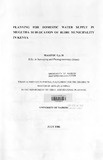| dc.description.abstract | The Kenya natural endowment of freshwater is limited. It is estimated that currently only
15 per cent of the country's potential yield of renewable fresh water resource has been
developed. Currently, access to safe water at national level is estimated at 68 per cent in
urban areas and 49 per cent in rural areas with the overall coverage and access declining
in terms of quality and quantity. Presently, the national coverage of safe drinking water
is estimated at only 40 per cent
Rapid urbanization in urban fringe areas stress the capacity of existing infrastructure
facilities and compromises the ability of the government and other agencies to provide
essential urban services, critical among them being domestic water supply. Attempts to
mitigate these problems have often been ineffective in space and time. Lack of clear
policies and effective legal and institutional mechanisms posses a major challenge to
sustainable urban development in urban fridge areas. The effect of Nairobi city urban
sprawl, rapid unplanned growth and informal settlement in Ruiru municipality has put
high pressure on the capacity of Ruiru Municipality water infrastructure.
This study examines the existing domestic water situation in the fast urbanizing Ruiru
- municipality in general and Mugutha Sub-location in particular with a view to making
viable proposals on how water demand can be met in an equitable and sustainable
manner within the framework of Integrated Resource Planning (lRP). Secondary and
primary data were collected using appropriate instruments. The statistical package for
social sciences (SPSS) was used to analyze field data while Excel was used to aid better
graphical presentation. Geographic Information System (GIS) was used for spatial
analysis.
The study found out that the main sources of water in the study area were surface water,
ground water and precipitation. Since the municipal authority is not a water undertaker,
the domestic water supply has been left to various water services providers. The study
further found out that the peri-urban area of Mugutha sub-location is largely rural in
nature with limited commercial and industrial activities. About 86 per cent of
respondents' houses were permanent in nature. Over 40 per cent of the respondents work in Nairobi and use various-modes of transport to access their work places, however, poor roads and drainage systems hampers mobility. The study found out that the majority of
households (71%) are not connected to piped water supply. This situation
contributes to low piped water coverage and poor equity of distribution in addition to
relatively low adequacy levels. The frequency of domestic water supply for those
households that are connected is rather discouraging as only 38 per cent receive their
supplies on daily basis. In the study area this study established that the main mode of
excreta disposal is use of pit latrines. About 80 per cent of the respondents indicated that
pit latrine was the only available mode of excreta disposal as adaptation of other
alternative modes depends on a reliable supply of piped water.
The study concludes that the level of domestic water supply coverage is low and the
distribution is not equitable. It is against this background that planning for domestic
water development and supply becomes an inevitable undertaking. Prudent water
demand management within the framework of Integrated Resources Planning is
advocated for sustainable development of the study area in particular and Ruiru
municipality in general.
Some of the recommendations made in the study include: Prudent water demand
management must be exercised through tariff and water saving measures such as
protection and conservation of water resources. The role of community water supplies
and water vendors should be enhanced and regulated to promote equitability and quality
water provision in the study area. | en |

